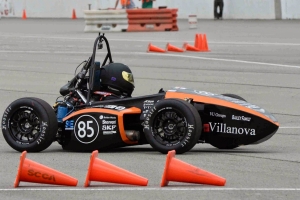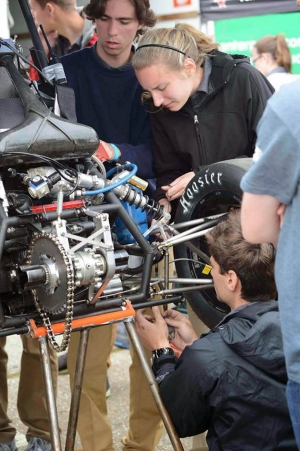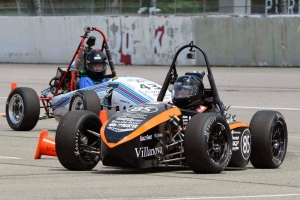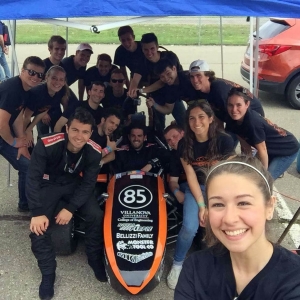Nova Racing Finds Success on Michigan Speedway

On May 12, 22 members of Nova Racing—Villanova University’s Formula SAE team—began a nearly 10-hour journey from Villanova, Pennsylvania to Brooklyn, Michigan for the 2015 Formula SAE competition at Michigan International Speedway. Throughout the next several days, the car that the team spent a year conceiving, designing, fabricating and testing would compete against more than 100 others from colleges and universities around the world. In the end, Nova Racing placed 18th overall, its best result since the team formed in 2008. In addition, the team placed in the top 10 in three specific judging events.

Now in its 34th year, SAE International’s Formula competition provides students with the real-world challenges of systems engineering, design and problem solving, along with the teaming challenges of collaboration and cooperation. Each year, teams are required to start at square one (previous years’ cars cannot be reused), working under the assumption that a manufacturing firm has engaged them to produce a prototype racecar for evaluation as a production item. The challenge is to design and fabricate a car that best meets the client’s goals and intents as described on the SAE website:
“The intended sales market is the nonprofessional weekend competitor. Therefore, the car must have very high performance in terms of its acceleration, braking, and handling qualities. The car must be low in cost, easy to maintain, and reliable. In addition, the car’s marketability is enhanced by other factors such as aesthetics, comfort and use of common parts.”
At the Michigan event, cars are judged in a series of static events: design, cost and presentation, and dynamic events: acceleration, autocross, skid-pad and endurance. Each event has specified minimum acceptable performance levels that are reflected in the scoring equations. This year, NovaRacing took 7th place in three events: cost report, acceleration and fuel economy, and 8th place in the fuel economy event. For the cost report, the students are to assume that a serial production of 1,000 cars a year will follow the prototype. According to the competition guide, the objective of the event is for the participants to learn and understand the manufacturing techniques and processes of some of the components that they have chosen to purchase rather than fabricate themselves. In the acceleration event, the cars are evaluated on their accelerating abilities from a standing start over a distance of 75 meters, and in the fuel economy event, efficiency is measured over the course of the endurance race.

Villanova’s 2015 entry into the Formula SAE competition, VU07, reflected lessons learned during last year’s dynamic events. Team captain Albert Montemuro ’15 ME explains, “Having not performed reliably last year, VU06 taught us the importance of a systems approach to full vehicle design, manufacturing and testing.” VU07 was modeled in a virtual reality simulator to ensure the integration of each system. Montemuro adds, “Some highlights of the 2015 car included increased reliability across the vehicle despite an overall weight loss, a heavily revised powertrain and a new data acquisition system.”

In placing 18th overall, Drosdick Endowed Dean of Engineering, Gary A. Gabriele, PhD, was happy to point out that NovaRacing beat many traditionally strong teams. He also mentioned that four of the 17 cars that placed ahead of Villanova’s were from European and Asian universities. International competitors at this year’s event included those from Austria, Brazil, Canada, Mexico, Poland, Singapore, South Korea and Venezuela.
“Awesome year, awesome finish,” says Montemuro. “We’re looking forward to pouring over the final results and seeing where our gains are for next year. Thanks to all who were involved and to all our fans who made it to competition to watch. Now work on VU08 can begin!”
For additional event photos and information about the NovaRacing team, visit their Facebook page or contact the team’s new captain, Sofia Gizzi at sgizzi@villanova.edu.
NovaRacing team members include: Andrew Armstrong, John Bellizzi, Casey Bono, Allison Boyd, Olivia Eltz, Robert Fichera, Paulius Gedvilas, Sofia Gizzi, Souhail Halaby, Nick Hammerle, Mike Henry, Gillian Krautman, Lucy Kruyff, Madeline Lopez, Joe Montemarano, Albert Montemuro (captain), Eric Pauls, Chris Peters, Isaac Rose, David Rudy, Zachery Smith and Brent Studenroth.
Photos by Joe Montemarana.
Now in its 34th year, SAE International’s Formula competition provides students with the real-world challenges of systems engineering, design and problem solving, along with the teaming challenges of collaboration and cooperation. Each year, teams are required to start at square one (previous years’ cars cannot be reused), working under the assumption that a manufacturing firm has engaged them to produce a prototype racecar for evaluation as a production item. The challenge is to design and fabricate a car that best meets the client’s goals and intents as described on the SAE website:
“The intended sales market is the nonprofessional weekend competitor. Therefore, the car must have very high performance in terms of its acceleration, braking, and handling qualities. The car must be low in cost, easy to maintain, and reliable. In addition, the car’s marketability is enhanced by other factors such as aesthetics, comfort and use of common parts.”
At the Michigan event, cars are judged in a series of static events: design, cost and presentation, and dynamic events: acceleration, autocross, skid-pad and endurance. Each event has specified minimum acceptable performance levels that are reflected in the scoring equations. This year, NovaRacing took 7thplace for both the cost report and acceleration event, and 8th place in the fuel economy event. For the cost report, the students are to assume that a serial production of 1,000 cars a year will follow the prototype. According to the competition guide, the objective of the event is for the participants to learn and understand the manufacturing techniques and processes of some of the components that they have chosen to purchase rather than fabricate themselves. In the acceleration event, the cars are evaluated on their accelerating abilities from a standing start over a distance of 75 meters, and in the fuel economy event, efficiency is measured over the course of the endurance race.
Villanova’s 2015 entry into the Formula SAE competition, VU07, reflected lessons learned during last year’s dynamic events. Team captain Albert Montemuro ’15 ME explains, “Having not performed reliably last year, VU06 taught us the importance of a systems approach to full vehicle design, manufacturing and testing.” VU07 was modeled in a virtual reality simulator to ensure the integration of each system. Montemuro adds, “Some highlights of the 2015 car included increased reliability across the vehicle despite an overall weight loss, a heavily revised powertrain and a new data acquisition system.”
In placing 18th overall, Drosdick Endowed Dean of Engineering, Gary A. Gabriele, PhD, was happy to point out that NovaRacing beat many traditionally strong teams. He also mentioned that four of the 17 cars that placed ahead of Villanova’s were from European and Asian universities. International competitors at this year’s event included those from Austria, Brazil, Canada, Mexico, Poland, Singapore, South Korea and Venezuela.
“Awesome year, awesome finish,” says Montemuro. “We’re looking forward to pouring over the final results and seeing where our gains are for next year. Thanks to all who were involved and to all our fans who made it to competition to watch. Now work on VU08 can begin!”
For additional event photos and information about the NovaRacing team, visit their Facebook page or contact the team’s new captain, Sofia Gizzi at sgizzi@villanova.edu.
NovaRacing team members include: Andrew Armstrong, John Bellizzi, Casey Bono, Allison Boyd, Olivia Eltz, Robert Fichera, Paulius Gedvilas, Sofia Gizzi, Souhail Halaby, Nick Hammerle, Mike Henry, Gillian Krautman, Lucy Kruyff, Madeline Lopez, Joe Montemarano, Albert Montemuro (captain), Eric Pauls, Chris Peters, Isaac Rose, David Rudy, Zachery Smith and Brent Studenroth.
Photos by Joe Montemarana.
Now in its 34th year, SAE International’s Formula competition provides students with the real-world challenges of systems engineering, design and problem solving, along with the teaming challenges of collaboration and cooperation. Each year, teams are required to start at square one (previous years’ cars cannot be reused), working under the assumption that a manufacturing firm has engaged them to produce a prototype racecar for evaluation as a production item. The challenge is to design and fabricate a car that best meets the client’s goals and intents as described on the SAE website:
“The intended sales market is the nonprofessional weekend competitor. Therefore, the car must have very high performance in terms of its acceleration, braking, and handling qualities. The car must be low in cost, easy to maintain, and reliable. In addition, the car’s marketability is enhanced by other factors such as aesthetics, comfort and use of common parts.”
At the Michigan event, cars are judged in a series of static events: design, cost and presentation, and dynamic events: acceleration, autocross, skid-pad and endurance. Each event has specified minimum acceptable performance levels that are reflected in the scoring equations. This year, NovaRacing took 7thplace for both the cost report and acceleration event, and 8th place in the fuel economy event. For the cost report, the students are to assume that a serial production of 1,000 cars a year will follow the prototype. According to the competition guide, the objective of the event is for the participants to learn and understand the manufacturing techniques and processes of some of the components that they have chosen to purchase rather than fabricate themselves. In the acceleration event, the cars are evaluated on their accelerating abilities from a standing start over a distance of 75 meters, and in the fuel economy event, efficiency is measured over the course of the endurance race.
Villanova’s 2015 entry into the Formula SAE competition, VU07, reflected lessons learned during last year’s dynamic events. Team captain Albert Montemuro ’15 ME explains, “Having not performed reliably last year, VU06 taught us the importance of a systems approach to full vehicle design, manufacturing and testing.” VU07 was modeled in a virtual reality simulator to ensure the integration of each system. Montemuro adds, “Some highlights of the 2015 car included increased reliability across the vehicle despite an overall weight loss, a heavily revised powertrain and a new data acquisition system.”
In placing 18th overall, Drosdick Endowed Dean of Engineering, Gary A. Gabriele, PhD, was happy to point out that NovaRacing beat many traditionally strong teams. He also mentioned that four of the 17 cars that placed ahead of Villanova’s were from European and Asian universities. International competitors at this year’s event included those from Austria, Brazil, Canada, Mexico, Poland, Singapore, South Korea and Venezuela.
“Awesome year, awesome finish,” says Montemuro. “We’re looking forward to pouring over the final results and seeing where our gains are for next year. Thanks to all who were involved and to all our fans who made it to competition to watch. Now work on VU08 can begin!”
For additional event photos and information about the NovaRacing team, visit their Facebook page or contact the team’s new captain, Sofia Gizzi at sgizzi@villanova.edu.
NovaRacing team members include: Andrew Armstrong, John Bellizzi, Casey Bono, Allison Boyd, Olivia Eltz, Robert Fichera, Paulius Gedvilas, Sofia Gizzi, Souhail Halaby, Nick Hammerle, Mike Henry, Gillian Krautman, Lucy Kruyff, Madeline Lopez, Joe Montemarano, Albert Montemuro (captain), Eric Pauls, Chris Peters, Isaac Rose, David Rudy, Zachery Smith and Brent Studenroth.
Photos by Joe Montemarana.
Now in its 34th year, SAE International’s Formula competition provides students with the real-world challenges of systems engineering, design and problem solving, along with the teaming challenges of collaboration and cooperation. Each year, teams are required to start at square one (previous years’ cars cannot be reused), working under the assumption that a manufacturing firm has engaged them to produce a prototype racecar for evaluation as a production item. The challenge is to design and fabricate a car that best meets the client’s goals and intents as described on the SAE website:
“The intended sales market is the nonprofessional weekend competitor. Therefore, the car must have very high performance in terms of its acceleration, braking, and handling qualities. The car must be low in cost, easy to maintain, and reliable. In addition, the car’s marketability is enhanced by other factors such as aesthetics, comfort and use of common parts.”
At the Michigan event, cars are judged in a series of static events: design, cost and presentation, and dynamic events: acceleration, autocross, skid-pad and endurance. Each event has specified minimum acceptable performance levels that are reflected in the scoring equations. This year, NovaRacing took 7thplace for both the cost report and acceleration event, and 8th place in the fuel economy event. For the cost report, the students are to assume that a serial production of 1,000 cars a year will follow the prototype. According to the competition guide, the objective of the event is for the participants to learn and understand the manufacturing techniques and processes of some of the components that they have chosen to purchase rather than fabricate themselves. In the acceleration event, the cars are evaluated on their accelerating abilities from a standing start over a distance of 75 meters, and in the fuel economy event, efficiency is measured over the course of the endurance race.
Villanova’s 2015 entry into the Formula SAE competition, VU07, reflected lessons learned during last year’s dynamic events. Team captain Albert Montemuro ’15 ME explains, “Having not performed reliably last year, VU06 taught us the importance of a systems approach to full vehicle design, manufacturing and testing.” VU07 was modeled in a virtual reality simulator to ensure the integration of each system. Montemuro adds, “Some highlights of the 2015 car included increased reliability across the vehicle despite an overall weight loss, a heavily revised powertrain and a new data acquisition system.”
In placing 18th overall, Drosdick Endowed Dean of Engineering, Gary A. Gabriele, PhD, was happy to point out that NovaRacing beat many traditionally strong teams. He also mentioned that four of the 17 cars that placed ahead of Villanova’s were from European and Asian universities. International competitors at this year’s event included those from Austria, Brazil, Canada, Mexico, Poland, Singapore, South Korea and Venezuela.
“Awesome year, awesome finish,” says Montemuro. “We’re looking forward to pouring over the final results and seeing where our gains are for next year. Thanks to all who were involved and to all our fans who made it to competition to watch. Now work on VU08 can begin!”
For additional event photos and information about the NovaRacing team, visit their Facebook page or contact the team’s new captain, Sofia Gizzi at sgizzi@villanova.edu.
NovaRacing team members include: Andrew Armstrong, John Bellizzi, Casey Bono, Allison Boyd, Olivia Eltz, Robert Fichera, Paulius Gedvilas, Sofia Gizzi, Souhail Halaby, Nick Hammerle, Mike Henry, Gillian Krautman, Lucy Kruyff, Madeline Lopez, Joe Montemarano, Albert Montemuro (captain), Eric Pauls, Chris Peters, Isaac Rose, David Rudy, Zachery Smith and Brent Studenroth.
Photos by Joe Montemarana.
